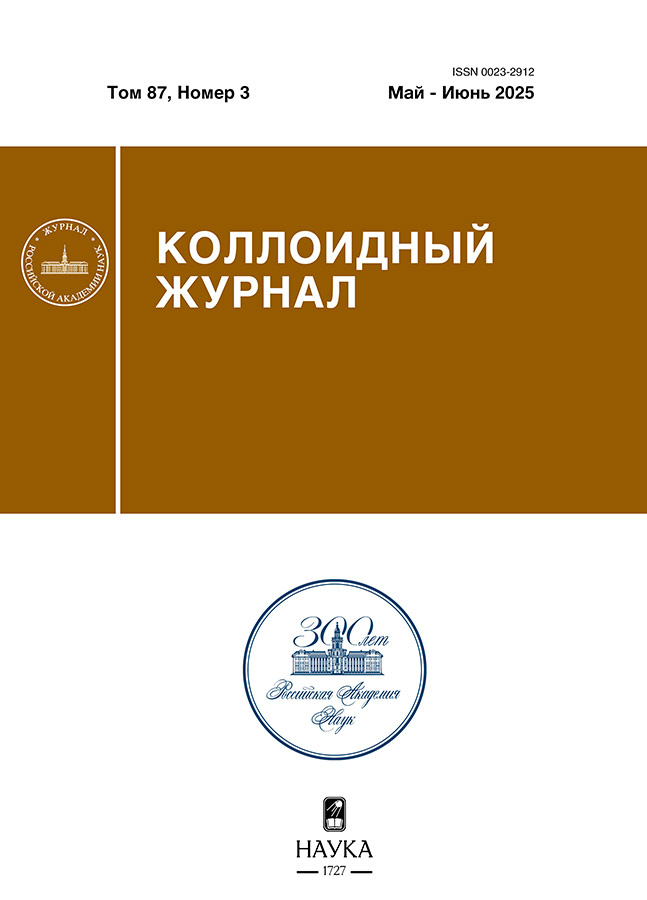Transformation of aqueous methyl methacrylate solution into stable monodisperse latex via polymerization initiated by hydroquinone–potassium persulfate system
- Autores: Hovhannisyan A.A.1, Grigoryan G.K.1, Nadaryan A.G.1, Grigoryan N.H.1
-
Afiliações:
- Scientific-Technological Center of Organic and Pharmaceutical Chemistry of the National Academy of Sciences of the Republic of Armenia
- Edição: Volume 87, Nº 3 (2025)
- Páginas: 240-245
- Seção: Articles
- ##submission.dateSubmitted##: 12.07.2025
- ##submission.dateAccepted##: 12.07.2025
- ##submission.datePublished##: 04.09.2025
- URL: https://ruspoj.com/0023-2912/article/view/687352
- DOI: https://doi.org/10.31857/S0023291225030064
- EDN: https://elibrary.ru/TALPVI
- ID: 687352
Citar
Texto integral
Resumo
The aim of this work was to identify the possibilities of synthesizing stable latex with a narrow particle distribution by homogeneous polymerization in an aqueous solution of methyl methacrylate. The polymerization of methyl methacrylate was first carried out under static conditions in an aqueous solution of the hydroquinone–potassium persulfate oxidation-reduction system. It was assumed that semiquinone anion radicals formed at the intermediate stage of hydroquinone oxidation can participate in the reactions of termination of growing radicals and by changing the molecular parameters of polymer molecules, affect the process of formation of latex particles. The article presents the results of the study of the colloidal parameters of the obtained latex, which show that the selected polymerization conditions allow reproducibly synthesizing monodisperse stable latex.
Texto integral
Sobre autores
A. Hovhannisyan
Scientific-Technological Center of Organic and Pharmaceutical Chemistry of the National Academy of Sciences of the Republic of Armenia
Autor responsável pela correspondência
Email: hovarnos@gmail.com
Armênia, 26, Azatutyunyan Ave., Yerevan, 0014
G. Grigoryan
Scientific-Technological Center of Organic and Pharmaceutical Chemistry of the National Academy of Sciences of the Republic of Armenia
Email: hovarnos@gmail.com
Armênia, 26, Azatutyunyan Ave., Yerevan, 0014
A. Nadaryan
Scientific-Technological Center of Organic and Pharmaceutical Chemistry of the National Academy of Sciences of the Republic of Armenia
Email: hovarnos@gmail.com
Armênia, 26, Azatutyunyan Ave., Yerevan, 0014
N. Grigoryan
Scientific-Technological Center of Organic and Pharmaceutical Chemistry of the National Academy of Sciences of the Republic of Armenia
Email: hovarnos@gmail.com
Armênia, 26, Azatutyunyan Ave., Yerevan, 0014
Bibliografia
- Grant T.D. Shouldice, Gerald A. Vandezande, Rudin A. Practical aspects of the emulsifier-free emulsion polymerization of styrene // Eur. Polym. J. 1994. V. 30. № 2. P. 179–183. https://doi.org/10.1016/0014-3057(94)90157-0
- Safinejad A., Pourmahdian S., Hadavand B.S. Emulsifier-free emulsion polymerization of acrylonitrile-butadiene-carboxylic acid monomers: a kinetic study based on polymerization pressure profile // J. Dispers. Sci. Technol. 2020. V. 41. № 2. P. 157–167. https://doi.org/10.1080/01932691.2018.1496835
- Chad E. Reese, Sanford A. Asher. Emulsifier-free emulsion polymerization produces highly charged, monodisperse particles for near infrared photonic crystals // J. Colloid Interface Sci. 2002. V. 248. № 1. P. 41–46. https://doi.org/10.1006/jcis.2001.8193
- Prokopov N.I., Gritskova I. A., Cherkasov V.R., Chalykh A.E. Synthesis of monodisperse functional polymer microspheres for immunological studies // Russ. Chem. Rev. 1996. V. 65. № 2. P. 167–180. https://doi.org/10.1070/RC1996v065n02ABEH000205
- Oganesyan A.A. Free-radical polymerization and phase formation in heterogeneous monomer/water systems, Doctoral (Chem.) Dissertation, Moscow: Moscow, Inst. of Fine Chemical Technology. 1986. (in Russ)
- Oganesyan A.A., Gukasyan A.V., Matsoyan S.G. Diffusion and polymerization of styrene in an aqueous solution of potassium persulfate under static conditions // Dokl. Phys. Chem. 1985. V. 281, № 4. P. 377. (in Russ)
- Oganesyan, A.A., Khaddazh, M., Gritskova, I.A. et al. Polymerization in the static heterogeneous system styrene-water in the presence of methanol // Theor. Found. Chem. Eng. 2013. V. 47 P. 600–603. https://doi.org/10.1134/S0040579513050230
- Nankai An, Xi Chen, Mingxin Zheng, Jinying Yuan. Colloidal crystals of monodisperse fluoro-nanoparticles by aqueous polymerization-induced self-assembly // Chem. Commun. 2023. V. 59. P. 7595–7598. https://doi.org/10.1039/D3CC01019H
- Zhong F., Pan C.-Y. Dispersion polymerization versus emulsifier-free emulsion polymerization for nano-object fabrication: A comprehensive comparison // Macromol. Rapid Commun. 2022. V. 43. № 3. P. 2100566. https://doi.org/10.1002/marc.202100566
- Peter A. Lovell, F. Joseph Schork. Fundamentals of emulsion polymerization // Biomacromolecules. 2020. V. 21. № 11. P. 4396–4441. https://doi.org/10.1021/acs.biomac.0c00769
- Шевченко Н.Н., Панкова Г.А., Шабсельс Б.М., Лаишевкина С.Г., Байгильдин В.А. Безэмульгаторная эмульсионная сополимеризация метилметакрилата как метод получения катионных частиц для диагностики вируса клещевого энцефалита // Коллоид. журн. 2020. Т. 82. № 2. С. 252–260.
- Menshikova A.Yu., Evseeva T.G., Peretolchin M.V., Chekina N.A., Ivanchev S.S. Emulsifier-free polymerization of methyl methacrylate with a carboxyl-containing initiator // Polym. Sci. A. 2001. V .43. № 4. P. 607–615.
- Троицкий Б.Б., Локтева А.А., Беганцова Ю.Е., Новикова М.А., Конев А.Н., Федюшкин И.Л. Получение наночастиц полиметилметакрилата диаметром 15–50 нм из латексных частиц субмикрометрового размера // Журнал Прикладной Химии. 2019. Т. 92. № 7. С. 875–880. https://doi.org/10.1134/S0044461819070089
- Walling Ch. Free radicals in solution. New York. Wiley. 1957.
- Dolgoplosk B.A. Tinyakova E.I. Generation of free radicals and their reactions. Moscow. Nauka, 1982.
- Guin P.S., Das S., Mandal P.C., Electrochemical reduction of quinones in different media: A review // Int. J. Electrochem. 2011. V. 2011. № 2. P. 816202.
- Додонов В. А., Гришин Д.Ф. Особенности полимеризации некоторых виниловых мономеров на элементоорганических инициаторах в присутствии гидрохинона // Высокомолекулярные соединения. Серия Б. 1993. Т. 35. № 1. С. 47–49.
- Robert M. Fitch, Michael B. Prenosil, Karen J. Sprick. The mechanism of particle formation in polymer hydrosols. I. Kinetics of aqueous polymerization of methyl methacrylate // J. Polym. Sci. Part C: Polym. Symp. 1969. V. 27. № 1. P. 95–118. https://doi.org/10.1002/polc.5070270109
- Fitch R.M., Tsai C.H. Polymer colloids particle formation in nonmicellar systems // J. Polym. Sci. Part B: Polym. Lett. 1970. V. 8. № 10. P. 703–710. https://doi.org/10.1002/pol.1970.110081007
- Fitch R.M. Latex particle nucleation and growth, in ACS Symposium Series, American Chemical Society: Washington, D.C. 1981. P. 1–29. https://doi.org/10.1021/bk-1981-0165.ch001
- Багдасаров Х.С., Гиваргизов Е.И., Демьянец Л.Н., Кузнецов В.А., Лабочев А.Н., Чернов А.А. Современная кристаллография. Том 3. Образование кристаллов. Москва: Наука. 1980.
- Moravec G. Macromolecules in solutions. M.: Mir. 1967.
- Frolov Yu.G. Course of colloid chemistry (Surface phenomena and disperse systems). M: Chemistry. 1982.
Arquivos suplementares
















